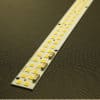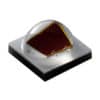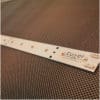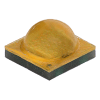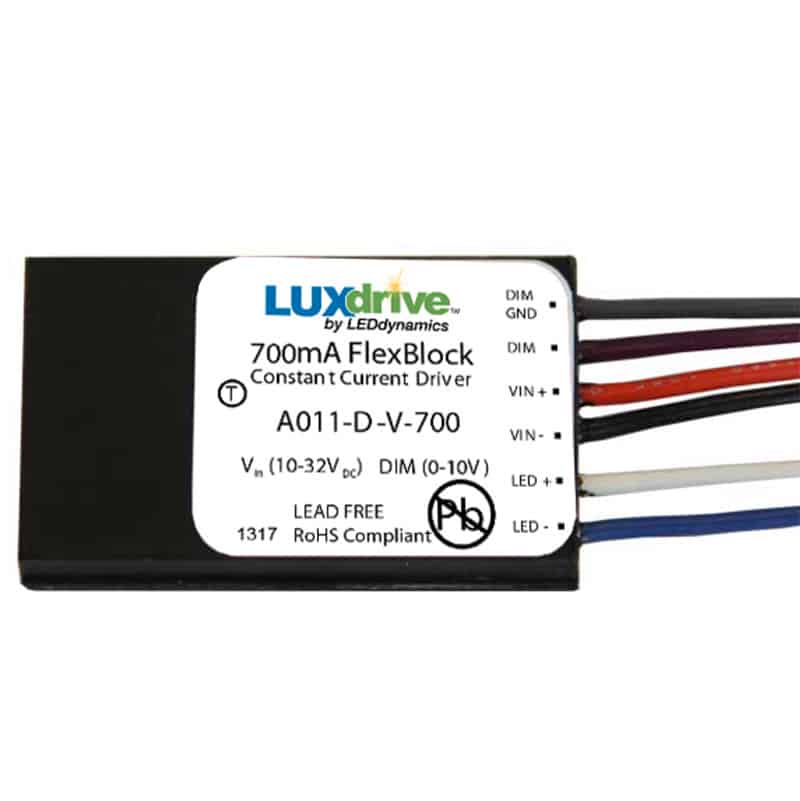Led Drivers
LUXdrive A011 FlexBlock: The Buck-Boosting FlexBlock LED Driver
What makes the LUXdrive A011 FlexBlock LED driver so powerful…The extremely compact dual-mode FlexBlock is a true current regulated LED driver for powering high-power or high-brightness (HB) LEDs or LED arrays; because the forward voltage of LEDs can change based on several environmental factors as well as the age of the LED, it is important to use this type of driver in an LED system to help avoid thermal runaway. The FlexBlock includes a fast response current-sensing circuit for applications where flashing or strobe of LEDs is required and its dimming input is also compatible with 0-10V wall mount dimmers like our 0-10v dimmer.
BUT…Here is what sets the FlexBlock apart from other constant current LED drivers.
The A011 FlexBlock is capable of two different modes:
Buck-Boost Mode
The versatility engineered into the FlexBlock allows it to handle LED loads that are ABOVE, BELOW or the SAME voltage as the power supply. This standard mode, called Buck-Boost mode, is recommend for loads up to 6 LEDs, but has the ability to output: 48Vdc minus the input Voltage. For example, if your input voltage is 12Vdc, the FlexBlock technically has the capability to output 36Vdc; at the same time and in the same mode, the FlexBlock could also run only 1-4 LEDs from 12Vdc.
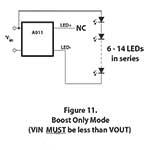
Figure 11 – Boost-Only
Boost-Only Mode
The FlexBlocks most efficient mode is Boost-Only. In this mode the FlexBlock LED+ output is not used, and the positive end of the LED load is instead connected to Vin+ (shown in figure 11). In Boost-Only mode the output voltage can reach 48Vdc, but it is extremely important that the Vin be less than the Vout.
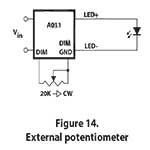
Figure 14 – Potentiometer
Dimming & Controlling Features
Dimming with potentiometer: The simplest method for dimming the FlexBlock is with a 20K Ohm potentiometer. This gives a 0%, 5-100% range of dimming. Figure 14 shows an example connection. Multiple FlexBlock can be dimmed together, however the value of the potentiometer should approximately be (20K Ohm / # of FlexBlocks).Dimming with 0-10V wall dimmer: The preferred choice of dimming a FlexBlock is with the 0-10V Dimmer module or another commercial wall dimming 0-10V control; the 0-10v dimmer can easily handle several drivers. The 0-10V control can also be supplied by a commercial lighting controller that has current sinking 0-10V outputs.
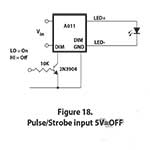
Figure 18 – PWM
Advanced Control with Pulse Width Modulation (PWM): The 0-10V input can be Pulse Width Modulated (PWM). Figure 18 shows how interfacing a micro-controller can easily be accomplished with a 2N2904 or equivalent transistor. A PWM frequency of 200Hz is recommended. The same configuration could also be used to pulse or strobe the LEDs with a TTL or CMOS logic signal.On/Off Control
The potentiometer in Figure 14 may be replaced by apush-button or toggle switch for on/off control. The output current will be zero and the input current will drop to the quiescent level when the switch is closed. Figures 16 and 17 show external dimming control combined with on/off control.
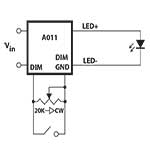
Figure 16
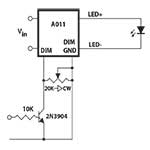
Figure 17
Thermal Management
The FlexBlock can run many LED load configurations with no heat sinking in an ambient of 25°C. In applications with elevated ambient temperatures, such as those that might be experienced inside an enclosed fixture, additional heat sinking may be required. If the temperature of the FlexBlock (measured at the T marking on the label) exceeds 60°C, additional heat sinking is recommended. If the temperature of the FlexBlock exceeds 80°C, additional heat sinking is required. The best surface for removing heat form the FlexBlock is the back side (opposite the label). If the FlexBlock becomes too hot during use, it will reduce the output current to limit the power dissipation. If the temperature continues to rise, the driver will turn off until the temperature drops to a safe level.
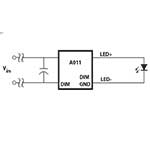
Figure 20
Connections
The LEDs being driven should be located as close to the FlexBlock LED output as possible. 18AWG wire should be adequate for most wiring, but a heavier gauge should be considered when long leads are necessary. The power input wires should also be kept short. Where the power source is located several feet from the unit, a 100μF or larger, 50V capacitor may be required across the input terminals as shown in Figure 20.FlexBlock Features:
DC input voltage up to 32V
350mA or 700mA constant current output
Extremely small form factor (2.0”x1.2”x0.38”)
18 AWG wires for easy electrical connections
External analog/digital intensity control
External potentiometer intensity control (0%, 5-100%)
Continuous output short circuit protection
Continuous output open circuit protection
Input reverse polarity protection with Polarifet™ Technology
Pulse and strobe capable (dim input)
FlexBlock Applications:
Solar & Landscape Lighting
Architectural Lighting
Track Lighting
Automotive & Marine Lighting
Portable Lighting & Flashlights
Point of Purchase Lighting
Desk & Reading Lamps
Signal & marker Lighting
Flashing & Strobe Lighting
Cabinet & Display Case Lighting
Sign & Channel Letters








